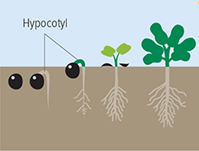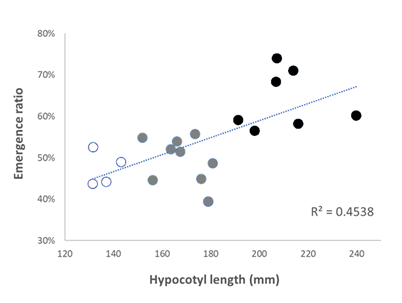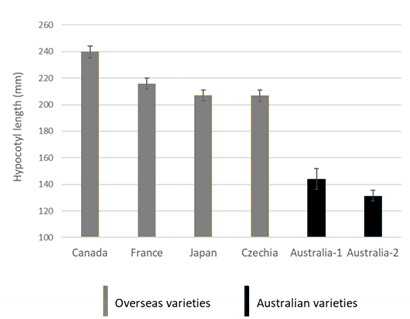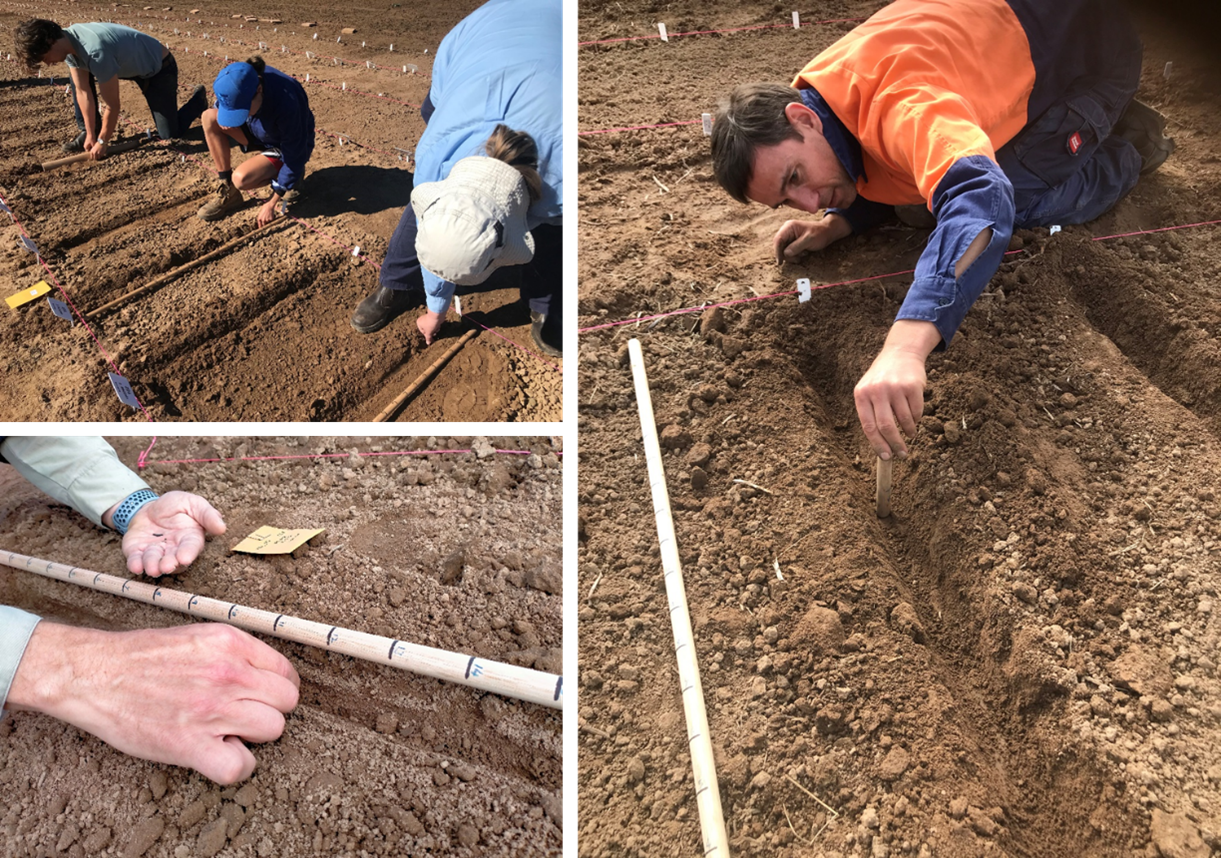The long and the short of it: How longer hypocotyls could improve canola establishment
The long and the short of it: How longer hypocotyls could improve canola establishment
Take home message
- The hypocotyl is the elongating stem between the root and cotyledons of canola seedlings
- Long hypocotyls are associated with better emergence of canola from deep sowing (50 mm)
- All Australian varieties have short-to-medium length hypocotyls, while several overseas varieties have been identified with long hypocotyls
- Long hypocotyl genes from overseas varieties are being incorporated into Australian canola varieties to improve establishment in deeper sown crops.
Aims
- To incorporate long hypocotyl genes from overseas varieties into locally adapted germplasm
- To confirm these genes improve establishment of Australian canola
- To provide improved germplasm and molecular markers to canola breeders.
Introduction
Canola (Brassica napus L.) production provided on average $4.1 billion per annum to the Australian economy over the last five years, making it Australia’s second most valuable crop (ABARES, 2023). Canola underpins the production of other important crops through its function as an important break crop in cereal-based rotations by breaking disease cycles and enabling the control of weeds.
One of the major challenges with canola is unreliable establishment (50% of germinable seeds establish on average; McMaster et al., 2019), which increases seed cost, and can reduce yield potential, increase weed-management requirements, and in extreme cases requires costly resowing. The direct and indirect costs of poor establishment to Australian growers can be conservatively estimated at between $100M–$200M annually. This problem is expected to worsen under a changing climate and with sowing into more marginal (hotter, drier) conditions.
Between 2019 and 2023, CSIRO and GRDC co-invested in a four-year research project (CSP1907-001RTX) to improve the genetics of canola establishment. After consultation with industry and reviewing the international scientific literature (Nelson et al., 2022a,b), long hypocotyls and early vigour (that is, fast and strong growth from germination through to around the four-leaf stage) were identified as critical targets for genetic improvement of canola establishment (Figure 1). Multiple lab- and field-based experiments were used to search for genetic diversity for these traits and to test their impact on canola establishment (Nelson et al., 2023). Among a diverse set of 255 open-pollinated canola varieties (comprising 101 historic Australian varieties and 154 overseas varieties) and 28 current Australian (mainly hybrid) varieties, it was discovered that current and historic Australian varieties all have short- to medium-length hypocotyls when screened using efficient and repeatable lab-based assays. The longest hypocotyl varieties all came from the major canola growing regions overseas (Nelson et al., 2023).

Figure 1. Schematic of early growth stages of canola seed with hypocotyl indicated. Image adapted from GRDC GroundCover
A subset of 20 contrasting varieties plus five current Australian varieties were then evaluated for field emergence and establishment from conventional (20 mm) and deep (50 mm) sowing in eight field experiments in NSW and WA in 2021 and 2022. Results showed the long hypocotyls identified in the lab were associated with improved emergence when canola was sown deep (Figure 2). It was also determined that hypocotyl length is controlled by several genes in contrast to the long coleoptile trait in wheat, which is controlled chiefly by one gene (Rebetzke et al., 2007).

Figure 2. The close relationship between hypocotyl length measured in controlled lab conditions and effective field emergence from deep (50 mm) relative to conventional (20 mm) sowing depths for 20 international varieties averaged across seven field experiments in NSW and WA in 2021 and 2022. White circles denote historic Australian varieties with short hypocotyls, grey circles denote overseas varieties with intermediate hypocotyl lengths, and black circles denote long hypocotyl overseas varieties.
Based on these positive results, in 2023 CSIRO and GRDC co-invested in a second phase of research through a five-year project (CSP2307-002RTX) that aims to transfer the long hypocotyl trait from overseas varieties into Australian varieties using rapid generation breeding, and to confirm the value of long hypocotyls for improving canola establishment. The project will provide long hypocotyl germplasm along with efficient selection tools to commercial breeding programs to develop the next generation of canola varieties with improved establishment. Below is an overview of the strategy to introduce the long hypocotyl trait into Australian canola.
Experimental approach
Selecting parents for crossing
From the previous lab-based screening of 255 open-pollinated varieties the longest hypocotyl varieties (between 206.4 – 240.0 mm in length) were from Canada, Czechia, France, Germany, Portugal, Japan, and the UK. Genetic analysis revealed that these 12 varieties represented four distinct genetic groupings so one variety from each of the four genetic groupings was selected to maximise the diversity of, and increase the likelihood of success in selecting, long hypocotyl genes (Figure 3). For the Australian canola crossing parents, two varieties were selected with short hypocotyls (to provide a contrast to the long hypocotyl donors) with high levels of early vigour. It had previously been discovered that the long hypocotyl trait was most effective in enabling emergence from deep sowing when combined with early vigour (Nelson et al., 2023).

Figure 3. Hypocotyl length of four overseas canola varieties (grey bars) selected as long hypocotyl trait donors to two vigorous Australian varieties (black bars). Error bars denote standard error of each variety mean.
Crossing strategy
Due to the poor adaptation of overseas varieties to Australian growing environments, two phases of population development were designed with the aim of producing breeding lines containing the long hypocotyl trait together with local Australian adaptation and quality:
- Introgression of long hypocotyl genes into Australian varieties through a backcrossing approach (2023 – 2026). This will involve crossing each of the four long hypocotyl donors to an Australian variety three times (while selecting for the long hypocotyl trait) followed by single seed descent for four further generations to produce 200 BC2S4 individuals per population. Rapid generation cycling methods will enable these populations to be produced within three years. The populations will be used for genetic mapping and molecular marker development for the long hypocotyl trait.
- Using the best individuals and the markers developed from Phase-1 population development, long hypocotyl alleles will be pyramided from the four donor sources into Australian varieties to create long hypocotyl ‘super-donors’. These will be provided to breeding companies to incorporate into their breeding programs. This process will take a further two years (2026 – 2028).
Field validation of long hypocotyl lines
The crossing activities described above will produce Australian-adapted lines incorporating long hypocotyl genes from overseas varieties. We will then confirm the effectiveness of the long hypocotyl trait for improving emergence, establishment, and final grain yield. This will involve two distinct experimental approaches during the 2026/27 and 2027/28 growing seasons:
- Single row-based evaluation of contrasting population ‘tails’ (that is, genetically related material with contrasting long versus short hypocotyls). These carefully managed, hand-sown experiments will be undertaken at six sites across NSW, SA, and WA with the primary aim of confirming the effectiveness of the long hypocotyl trait for improved emergence and establishment from conventional (20 mm) and deep (50 mm) sowing depths. Figure 4 gives an impression of the precise, manually-intensive nature of this approach using images taken during similar experiments in the previous project.
- Plot-based evaluation of the same contrasting population tails in cooperation with canola breeding companies targeting a minimum of eight sites per year. Some experiments will be located at NVT sites to facilitate their dual use as grower demonstration plots. The plots will be assessed for emergence, establishment, and vigour, and will be the first opportunity to measure the effect of the long hypocotyl trait on grain yield.

Figure 4. Illustrative images from single-row establishment experiments carried out at the Boorowa Agricultural Research Station in 2021 and 2022. Each seed was placed carefully in a specified position at 20mm or 50 mm depth, and then monitored closely until the fourth leaf stage. Photo: John Kirkegaard
Summing-up
In the previous project, overseas canola varieties with long hypocotyls were identified and were able to emerge better from deep sowing than any Australian variety tested. In this project, these long hypocotyl genes will be transferred into Australian varieties using rapid generation breeding, their value for improving canola establishment assessed, and then determine if the long hypocotyl trait influences final grain yield. The project will provide long hypocotyl germplasm along with efficient selection tools to commercial breeding programs thereby enabling the development of the next generation of canola varieties with improved establishment potential.
References
ABARES (2023) Agricultural Commodities report, December 2023
McMaster C, Stevenson A, Menz I (2019) Canola establishment across central NSW. Proceedings GRDC Grains Research Update, Wagga Wagga, February 2019, pp. 229-234.
Nelson MN, Nesi N, Barrero JM, Fletcher AL, Greaves IK, Hughes T, Laperche A, Snowdon R, Rebetzke GJ, Kirkegaard JA (2022a) Strategies to improve field establishment of canola: a review. Advances in Agronomy 175:133-177
Nelson M, Barrero J, Cmiel M, Fletcher A, Greaves I, Hughes T, Toovey A, Treble K, Zwart A, Kirkegaard J, Rebetzke G (2022b) Genetic improvement of canola establishment. GRDC Research Updates
Nelson M, Barrero J, Cmiel M, Fletcher A, Greaves I, Hughes T, Toovey A, Treble K, Zwart A, Kirkegaard J, Rebetzke G (2023) New genetics for improved canola establishment. GRDC Research Updates
Rebetzke GJ, Richards RA, Fettell NA, Long M, Condon AG, Forrester RI, Botwright TL (2007) Genotypic increases in coleoptile length improves stand establishment, vigour and grain yield of deep-sown wheat. Field Crops Research 100:10-23
Acknowledgements
The research undertaken as part of these projects is made possible by the significant contributions of growers through both trial cooperation and the support of the GRDC, the authors would like to thank them for their continued support. We thank CSIRO colleagues from CSIRO/GRDC canola phenology project (CSP1901-002RTX) for providing seedlots and genetic information for the panel of 255 diverse international varieties. We also thank the canola breeding companies for providing seeds of current varieties and ongoing engagement with the new project (CSP2307-002RTX). We thank Kalyx, Living Farm and the Boorowa Agricultural Research Station staff for assisting in setting up and/or monitoring field experiments in the previous project (CSP1907-001RTX).
Contact details
Dr. Matthew Nelson
CSIRO Agriculture and Food
Floreat Laboratories
147 Underwood Avenue, Floreat, Perth WA 6014
Ph: 0490 139 509
Email: matthew.nelson@csiro.au
Twitter: @Matthew67636066
Date published
February 2024
GRDC Project Code: CSP1907-001RTX, CSP2307-002RTX,
